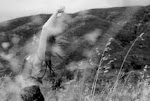
What happens when things don't go the way we expect them to in a relationship? What happens when your partner becomes someone you don't like so much? Are you willing to retrace your steps? Is he or she? Are you willing to recognize your own doings or are you the one to blame it all on your partner?
Miguel Espeche is an Argentinian Psychologist whose work we have set our eyes on. He has coordinated workshops in Buenos Aires for 22 years. These workshops are quite famous in the city. The topics are so varied (bonding, sexuality, family, aging, working), there is something for everyone.
Here is an extract of one of his cases we have translated:
"He didn't take everything away"
"His departure left loneliness and a lot of pain. He took everything when he left". She felt lonely, infinitely sad and most of all, deserted.
For her, he had been the mirror in which she had reflected and recognized herself for many years but her mirror was no longer there. She found herself caressing her kids at night, telling them words she wasn't sure of, looking at the world through a cold glass. All this because he wasn't there, because she remained at their home surrounded by their furniture and the objects that had been theirs for ages, objects that now seemed soulless, like her.
For good or for bad she had given him everything, even her own identity. She had chosen to be the verb instead of the subject, not because she was foolish, but because that was the way things unfolded. For her, it was a relief to have someone assume matters concerned with her own being and she went with it, she did what she thought was expected of her, she turned into an echo, instead of being the source of sound.
Time went by and she was surprised to feel alive again. She began to feel new emotions, these emotions were not his echo, they came from her own self, a source she started to like and value as others did. He, on the other side, felt that he had taken with him his own shadow, the one that was obstructing her personal feelings, her voice. She began to have her own dreams and desires and realized that he didn't have much to do with that anymore. She started feeling better, happier. She concluded he hadn't taken everything, he had only taken a part of her history.
Today they are flirting again, although they are still separated (this is a real story that is taking place). I don't know how this story will end but it is interesting to see how it is developing. He has already said that he felt saturated by what first attracted him to her "being everything for her", the undeniable center of her attention. She had also liked delegating her own being in that man. He had "broken the rules" of the game saying he felt lonely and in need of the company of someone else's voice, not just an echo of his own".
We think that if things get out of balance, it is up to each person in the couple to rediscover love without turning the other person into (or becoming) the subordinate, which as the extract shows, can ruin a relationship.
There are no villains in relationships. If there is love, difficulties can be overcome by trying to understand what each person's contribution to its wrong doing is. By working together finding healthier ways of relating to one another the relationship will obviously bring a lot of satisfaction and happiness.
Migue Espeche once said: "Healthy people suffer from love, that doesn't just happen to fools or ill people. The people that have the courage to assume the risks love requires are however, probably the healthiest."
Translation by Valeria Mendez Cañas extract from the July issue of Sophia Magazine
































